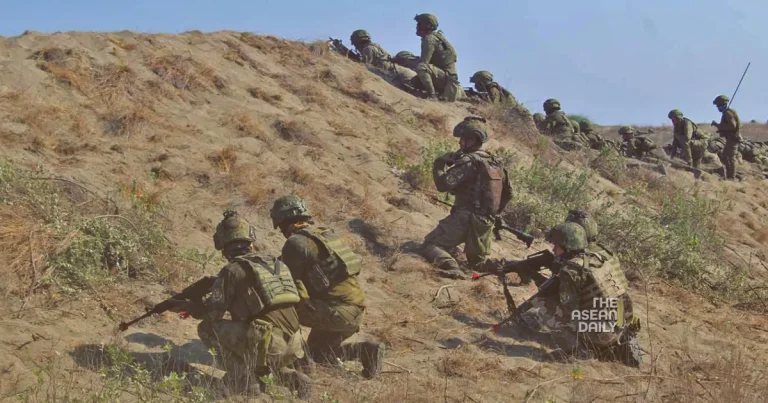6-5-2024 (MANILA) Amidst escalating tensions in the South China Sea and growing concerns over China’s assertive actions in the region, US and Filipino troops engaged in a joint military exercise on the northern coast of the Philippines on Monday. The war games, involving thousands of personnel, witnessed the firing of missiles and artillery at an imaginary “invasion” force, sending a powerful message of deterrence and readiness to defend territorial interests.
The live-fire exercise, conducted at a strip of sand dunes on the northwest coast of Luzon island, approximately 400 kilometers south of Taiwan, saw US troops unleash more than 50 live 155mm howitzer rounds at floating targets positioned about 5 kilometers offshore. This display of firepower was followed by Filipino troops firing rockets aimed at wearing down the simulated attackers, before both forces combined their efforts with machine guns, Javelin missiles, and additional artillery rounds.
Lieutenant General Michael Cederholm, commander of the US First Marine Expeditionary Force, emphasized that the exercise was designed “to prepare for the worst” by “securing key maritime terrain.” He stressed the importance of being ready to “repel an invasion,” underscoring the growing concerns over potential conflicts in the region.
Major General Marvin Licudine, the exercise director for the Filipino contingent, highlighted the strategic significance of the northwestern coast, stating, “Our northwestern side is more exposed.” He further added, “Because of the regional problems that we have, we have to already practice and orient ourselves in our own land in these parts.”
The joint military drills, dubbed “Balikatan” or “shoulder to shoulder” in Tagalog, involve more than 16,700 Filipino and American troops and are being conducted at multiple locations across the Philippine archipelago. The exercises come against the backdrop of increased confrontations between Chinese and Filipino vessels around shoals in the South China Sea claimed by Manila, as well as heightened Chinese air and naval activity around the self-ruled island of Taiwan.
Just last week, Manila accused the China Coast Guard of damaging a Philippine Coast Guard ship and another government vessel in water cannon attacks near the disputed Scarborough Shoal in the South China Sea on April 30. These maritime confrontations have raised fears of a wider conflict that could potentially involve the United States and other allies.
The recent exercise follows a joint statement issued by the defense ministers of the Philippines, the United States, Japan, and Australia, expressing strong objections to the “dangerous and destabilizing conduct” of China in the South China Sea. The ministers discussed opportunities to further advance defense cooperation and work together to support states exercising their rights and freedoms in the disputed waters.
Last week, US forces participating in the Balikatan exercises fired HIMARS precision rockets into the South China Sea from the western island of Palawan, the nearest major Philippine landmass to the hotly disputed Spratly Islands. The US Marine Corps described the maneuver as a rehearsal for the rapid deployment of the missile system across the Philippines’ South China Sea coast to “secure and protect Philippines’ maritime terrain, territorial waters, and exclusive economic zone interests.”
The tensions between the Philippines and China coincide with escalating tensions between Beijing and Taipei, with Taiwan’s defense ministry detecting multiple Chinese aircraft and naval vessels around the self-ruled island in recent days. Taiwan is set to inaugurate a new president whom China regards as a dangerous separatist, further fueling concerns over potential conflicts.
Philippine Foreign Secretary Enrique Manalo acknowledged the significance of military exercises as a form of deterrence, stating, “The more we simulate, the less we actuate.” The joint drills between the US and Filipino forces serve as a powerful demonstration of their commitment to regional security and their readiness to defend their territorial interests in the face of growing challenges.




